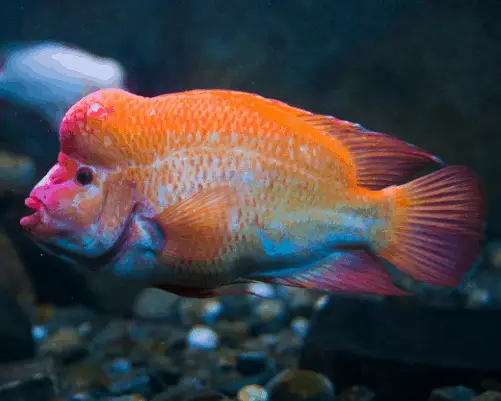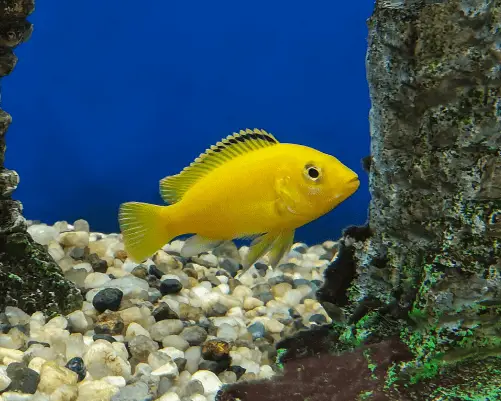If you have recently bought yourself a new cichlid, you may have noticed after a few weeks that their colour has started to change.
Is it possible for cichlids to change colours, or is it a sign of an underlying health condition?
Cichlids can change colour as they grow older or when exposed to stressful conditions. Colour changing can either be a natural process or a result of the stress hormones produced when their environment changes or a new fish is introduced.
Keep reading to learn why colour changes in your cichlid can occur and if there’s anything you can do to prevent or encourage it.

Cichlids Can Change Colour Due to Ageing or an Illness
It doesn’t necessarily mean a bad thing if you notice your cichlid changing colour. It may just be ageing, or just feeling happy in their environment. But it’s also important to make sure that your fish is healthy because diseases can also cause colour changes in fish.
The following discusses potential colour changes in cichlid in a bit more detail.
Ageing Can Cause Colour Change in Cichlids.
The main reason your cichlid’s colour can change is natural ageing. Baby fish will typically have very dull colours compared to adults, and their patterns often won’t appear in full until the fish reaches maturity.
One of the most common instances where you’ll see a colour change in your cichlid is if you buy it when it is only very young. They’ll typically come to you a relatively dull colour, although it should still resemble the adult colouration, and over time that colour will come in more strongly.
Cichlids are probably one of the clearest examples of changes in colour as they mature. Many cichlids can look completely different as an adult to how they were as a baby, especially for the dominant males.

Diseases Can Cause Cichlids To Change Colour.
If your fish suddenly begins to change colour, a very common reason is that they’re suffering from a disease. The most common illnesses that’ll change your fish’s colour are fin rot and white spot disease.
I’ll discuss white spot disease in a later section of this article, so let’s focus on fin rot for now.
Fin rot is typically a fungal condition that occurs because of poor water quality, usually combined with a previous injury. It tends to happen when some damage occurs to your fish’s fin. Then because of poor water quality, a fungal or bacterial infection will set in.
The first symptom of this is that your fish’s injury isn’t healing, or it’s actually getting slightly worse. That’s when you’ll start to notice blackening around the edges of the injury, as well as pieces of the fin beginning to rot away and fall off.
As with all colour changes, sometimes it can be difficult to determine whether or not it’s a problem or a simple colour change. To decide whether or not it’s fin rot, you’ll want to look for one main thing, whether or not the injury to the fin is getting worse.
If the fin is healing from the injury or looks completely fine, you’re probably not dealing with fin rot. You could still be dealing with an ammonia burn, but that should heal just fine with hygienic tank conditions.
What Colours Can Cichlids Be?

Cichlids come in a wide variety of colours. There are literally hundreds of different species of cichlid currently recognised, as they also cover fish like Discus, Angelfish and Oscars. However, with all of the individual variations that these fish can have, your variety of cichlid can possibly appear even more diverse.
Can Cichlids Lose Their Colour?
Cichlids can lose their colour when placed in stressful situations. They can also lose their colour as they get closer to the end of their lifetime. More energy will be put toward maintaining other bodily functions and less toward their pigment.
When you look at tropical fish guides online, they state that one of the most obvious symptoms that a fish is suffering from some ailment is that its colour begins to dull or darken.
If you add a new tank mate or ornament to your aquarium, then their colours may begin to dull as a stress response. It’s also especially common after shipping, so if you get your new cichlid via online delivery and it seems to be a duller colour than it was on the website, make sure you give it a few days before judging it. Just when you think you’ve been given the wrong fish, its colours will often brighten up just as soon as it has settled into its new environment.
Another common situation that fish will lose their colour is when they’re suffering from a disease, in poor health, or simply just unhappy in an overcrowded pet shop fish tank. I’ve often had the experience of purchasing a fish from a pet shop thinking that they were one colour, only to have their colour change significantly after a few months of a good diet and tank conditions.
Why Does My Cichlid Have White Spots?
You need to pay attention if your cichlid starts to show white spots or specks. Yes, it could just be some natural colour variation coming through, but it could also be Ich, also known as white spot disease. Ich needs action to be taken immediately to try and prevent almost certain death in your tank.
Ich Can Cause Your Cichlid To Act Oddly
Ich is a highly contagious fish disease that’s caused by a parasite. It tends to attack fish when they’re already weakened, so purchase and shipping is the prime time to acquire the disease.
It can be pretty hard to identify Ich, especially if you have a white fish or a fish with some white colouration. But there are a few telltale signs you can look for, including changes and behaviour and the appearance of the spots.
Ich has a relatively long life cycle, which is one reason it’s so hard to eradicate, but because of that, it can also be hard to spot, especially if it’s in one of the non-visible life cycle stages.
In Ich’s first stage, the parasite will enter the fish’s body and move around beneath its skin and tissue, feeding on their cells. In this stage, you’ll be unable to see any visual expression of the Ich, but you may notice that something is wrong with your fish’s behaviour. Typically, your fish will start swimming around with clamped fins, and they may also begin to rub up against any ornaments in your tank.
After the parasite has matured, it’ll turn into a hardened cyst to be released from the fish’s body to return to the substrate and restart the life cycle. This is the stage that you can see Ich in. It should appear like tiny white specks on your fish’s body. It’s what can make it hard to identify. After all, if your fish naturally has white specks, how are you supposed to distinguish the Ich specks from the natural colouration?
Ich specks are typically around the size of a grain of salt, smaller than most speckles that you’ll see on your fish. They’re also matte, while fish scales are typically shiny. Plus, they spread.
When you first notice the specks take a good look at your fish, maybe even take a few photos. Then a day or two later, recheck your fish to see if there are more specks than before. If more specks are present, chances are your fish is suffering from Ich.
Can All Cichlids Change Colour?
All cichlid species can change colour over time. Their pigment when a baby can conceal many other colours, so if yellow or silver starts to peek through, they’re not changing to a new colour. They’re just revealing more.
Conclusion

Cichlids can change colour over their lifetime. Over time, the amount of pigment in their bodies can change, revealing hidden colours or covering previously visible ones.
Their colour change can also occur due to stress during an illness, rehoming, or when introduced to a new tankmate. It’s essential to know the symptoms of common fish illnesses so you can identify when it’s a simple colour change or something more serious.


